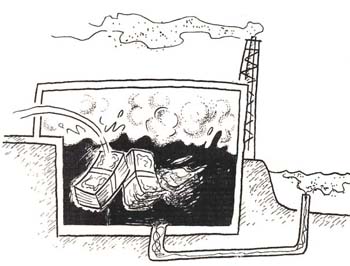Rokkasho Active Tests: Baku’s View Nuke Info Tokyo No. 112
On March 31st “active tests”, using spent nuclear fuel, began at Japan Nuclear Fuel Ltd’s (JNFL) Rokkasho reprocessing plant in Aomori Prefecture. On this day the spent fuel was only carried from the storage pool. Shearing of the fuel didn’t begin until the following day. However, according to newspaper reports, by simply commencing active tests before the end of the 2005 fiscal year, JNFL will receive payment of over 10 billion yen. (March 31st is the last day of the Japanese fiscal year.)
 |
|
Cartoon by Shoji Takagi
|
A safety agreement between JNFL, Aomori Prefecture and Rokkasho Village was required before the tests could begin. A draft agreement was presented to the prefectural assembly on February 16th, the agreement was signed on March 29th, and the tests began on the 31st, the same day that a safety agreement was signed with other surrounding towns and villages. It all happened in a great rush compared to the uranium tests, which started at the end of 2004. The draft safety agreement for those tests was submitted on 23 June 2004, but the tests didn’t start until December 21st. On that occasion the whole process took four times as long.
So who was in such a hurry? Tsunehisa Katsumata, President of Tokyo Electric Power Company, has said that if they don’t reprocess the spent fuel they will run out of storage space and will have to stop producing electricity. That contradicts the official reason for reprocessing, “to recycle the spent fuel”. It seems to reflect the true feelings of the power companies, but the situation isn’t really as desperate as all that. Rather, Katsumata’s comment seems to be an excuse to account for the appearance of haste.
A local Aomori newspaper quoted an unidentified person from within a nuclear power company as saying that he believes there was strong pressure from the government and from elements within the Liberal Democratic Party, the major partner in the ruling coalition. This statement reveals the lack of enthusiasm and indeed the irresponsibility of the power companies, which by rights should be the ones taking the lead in the project. After all, 75% of JNFL’s capital comes from the power companies. Effectively it is a joint subsidiary of the power companies.
The power companies are not really in a hurry to proceed with reprocessing. In fact, before the uranium tests commenced there were moves within the power companies, JNFL and the Ministry for Economy, Trade and Industry to prevent the tests from proceeding. They were afraid of accidents and they didn’t want the trouble of cleaning up the radioactive mess the plant would create. Once plutonium is separated they will have to use it even if they don’t want to. If they don’t use it, international criticism will become stronger. As the uranium tests approached, influential people in Aomori Prefecture and national politicians were lobbied, while famous people were used in an attempt to shape public opinion against operating the plant.
But in Japan pre-existing facts carry great weight. No one is willing to come forward to take responsibility for canceling programs. Unfortunately, having failed to prevent the uranium tests from starting, those responsible advance the program according to plan and obstinately assert that there are no problems with the policy. The most realistic approach for them now that the plant has commenced operations is to eye the plutonium supply-demand balance, hold down output and stubbornly defend their position.
Having said that, if an excuse could be found, it is still possible to reverse course, as they are well aware. And if they won’t take responsibility, it is up to us to drive them into a corner so that they have no choice but to reverse course.
Active tests have started, but it is still possible to stop the Rokkasho reprocessing plant. Indeed it is essential that we stop it.
Baku Nishio (CNIC Co-Director)
